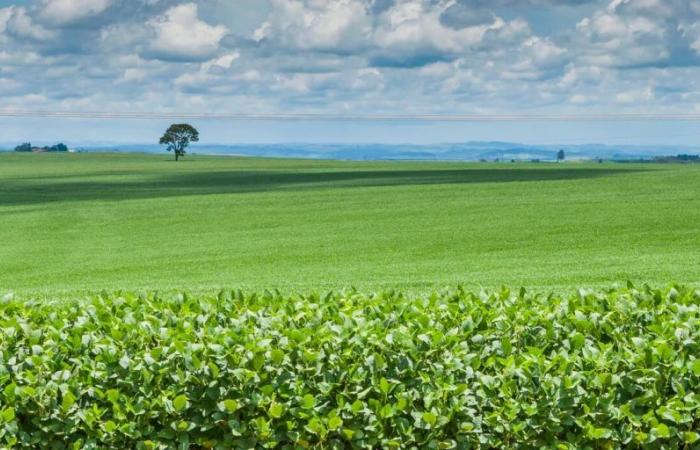Embrapa Soja will participate in ExpoLondrina 2024, promoted by Sociedade Rural do Paraná, at the Governador Ney Braga Exhibition Park, from April 5th to 14th, in Londrina (PR), presenting, at the institutional stand, some technologies that make up sustainable production of soybean cultivation, with an emphasis on bioinputs, genetic variability and Agricultural Climate Risk Zoning (ZARC-SOJA). Furthermore, Embrapa Soja, in partnership with the Institute for Rural Development of Paraná (IDR-Paraná), will promote the Sustainable Soy Production panel in Paraná, on April 11th, at 2pm, at the SmartAgro Pavilion. Advance registration can be done here. Bioinputs, ZARC and seeds To meet the growing challenges related to the use of bioinputs, Embrapa Soja invests in research to increase the participation of biological inputs in controlling insect pests, diseases and promoting plant growth. According to researcher Mariangela Virgínia, Brazil is a world leader in the use of bio-inputs classified as inoculants, which totally or partially replace chemical nitrogen fertilizers. “In soybean cultivation alone, more than 25 billion dollars are saved annually by the use of inoculants with nitrogen-fixing bacteria”, reports the researcher. As of 2023, the Agricultural Climate Risk Zoning (ZARC) for soybean cultivation began to adopt more comprehensive parameters regarding the characterization of classes of water available in the soil. According to researcher José Renato Bouças Farias, since 1996, ZARC SOJA had been using a classification with three types of soil, basically established by clay content, to estimate available water. From 2023 onwards, the new methodology began to adopt six classes of available water (AD), defined based on the textural composition of the soils (silt, sand and clay). The estimate began to be customized for the soil of each production area. “These changes to the ZARC expand the scope of evaluating the reality of Brazilian production systems, better expressing the risks associated with soybean production”, explains Farias. “Our objective is to minimize risks and enable greater production and income stability for soybean farmers, which is strategic for maintaining Brazilian production capacity”, explains the researcher. Embrapa Soja curates one of the largest soy collections in the world: there are 65 thousand types of soy. This collection is stored in the Active Germplasm Bank (BAG), at Embrapa Soja, with the aim of preserving the genetic variability of the grain. Maintaining the BAG is essential to support genetic improvement programs in the development of new, more productive soybean cultivars, with better health and agronomic characteristics of interest. Part of this collection will be demonstrated by Embrapa Soja, during ExpoLondrina.
Embrapa Soja will participate in ExpoLondrina 2024, promoted by Sociedade Rural do Paraná, at the Governador Ney Braga Exhibition Park, from April 5th to 14th, in Londrina (PR), presenting, at the institutional stand, some technologies that make up sustainable production of soybean cultivation, with an emphasis on bioinputs, genetic variability and Agricultural Climate Risk Zoning (ZARC-SOJA).
Furthermore, Embrapa Soja, in partnership with the Institute for Rural Development of Paraná (IDR-Paraná), will promote the Sustainable Soy Production panel in Paraná, on April 11th, at 2pm, at the SmartAgro Pavilion. Advance registration can be done here.
Bioinputs, ZARC and seeds
To meet the growing challenges related to the use of bio-inputs, Embrapa Soja invests in research to increase the participation of biological inputs in controlling insect pests, diseases and promoting plant growth. According to researcher Mariangela Virgínia, Brazil is a world leader in the use of bio-inputs classified as inoculants, which totally or partially replace chemical nitrogen fertilizers. “In soybean cultivation alone, more than 25 billion dollars are saved annually by the use of inoculants with nitrogen-fixing bacteria”, reports the researcher.
As of 2023, the Agricultural Climate Risk Zoning (ZARC) for soybean cultivation began to adopt more comprehensive parameters regarding the characterization of classes of water available in the soil. According to researcher José Renato Bouças Farias, since 1996, ZARC SOJA had been using a classification with three types of soil, basically established by clay content, to estimate available water. From 2023 onwards, the new methodology began to adopt six classes of available water (AD), defined based on the textural composition of the soils (silt, sand and clay). The estimate began to be customized for the soil of each production area.
“These changes to the ZARC expand the scope of evaluating the reality of Brazilian production systems, better expressing the risks associated with soybean production”, explains Farias. “Our objective is to minimize risks and enable greater production and income stability for soybean farmers, which is strategic for maintaining Brazilian production capacity”, explains the researcher.
Embrapa Soja curates one of the largest soy collections in the world: there are 65 thousand types of soy. This collection is stored in the Active Germplasm Bank (BAG), at Embrapa Soja, with the aim of preserving the genetic variability of the grain. Maintaining the BAG is essential to support genetic improvement programs in the development of new, more productive soybean cultivars, with better health and agronomic characteristics of interest. Part of this collection will be demonstrated by Embrapa Soja, during ExpoLondrina.
Tags: Embrapa takes pillars sustainable soy production ExpoLondrina






